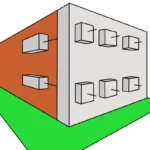Concrete impressions, also known as concrete stamping or concrete decoration, are a specialized technique in which concrete surfaces are transformed into aesthetically pleasing and realistic works of art. Through this technique, the texture and appearance of natural materials such as wood, stone, brick, pavers, and others are successfully mimicked, without compromising the inherent durability and strength of concrete.
Techniques in Concrete Impressions
There are two main techniques for carrying out concrete impressions:
Relief Impressions: This technique involves the use of special texture molds that are pressed onto the surface of fresh concrete. These molds can be made of various materials, such as rubber, plastic, or even wood. When pressed into fresh concrete, they create a realistic texture that imitates the appearance of natural materials. This is achieved by transferring the mold’s texture directly onto the concrete before it fully hardens.
Stamped Impressions: In this method, texture stamps are used to imprint patterns and designs on fresh concrete. The stamps can be intricate and customized, allowing for an almost infinite variety of designs. After the concrete has reached a certain stiffness, dyes and sealers are applied to enhance the appearance and durability of the surface. This provides the opportunity to create concrete surfaces with impressively beautiful and versatile impressions.
To work with the concrete impressions technique, an engineer must possess a combination of technical skills and knowledge in construction and design. The following describes the skills and professional profile beneficial for excelling in this field:
Civil Engineering or Architecture Knowledge: A degree in civil engineering or architecture provides the necessary technical foundation to understand structural design principles and the nature of concrete as a building material.
Construction Experience: Previous experience in construction projects is valuable for understanding industry procedures and standards. This may include construction project management or on-site work.
Concrete Knowledge: A deep understanding of concrete properties, mixing, and curing is essential for effectively carrying out concrete impressions. This includes understanding water-cement ratios and concrete curing.
Design and Aesthetic Skills: To create appealing concrete impressions, a keen sense of design and aesthetics is needed. This involves the ability to select suitable patterns and textures to achieve the desired look.
Concrete Impression Techniques Knowledge: Familiarity with specific concrete impression techniques, such as relief imprinting and stamping, is crucial for executing projects successfully.
Ability to Work with Specific Tools and Equipment: An engineer working with concrete impressions must be comfortable using specialized tools and equipment, such as molds, stamps, mixing and application tools, and safety equipment.
Awareness of Regulations and Codes: Understanding local regulations and building codes related to concrete and impression techniques is fundamental to ensuring projects meet legal and safety standards.
Project Management Skills: The ability to manage projects, including planning, budgeting, and team coordination, is important for efficiently carrying out concrete impression projects within deadlines.
Problem-Solving Skills: Unexpected challenges may arise in concrete impression projects, as in any construction field. An engineer should be capable of addressing and resolving issues effectively.
Creativity and Innovative Thinking: Creativity is essential for designing unique patterns and textures on concrete surfaces. Innovative thinking can lead to truly exceptional concrete impression projects.
An engineer wishing to work with the concrete impressions technique must combine their knowledge in civil engineering or architecture with specific skills in concrete, design, project management, and the ability to work with specialized tools and equipment. This combination of knowledge and skills allows the engineer to create impressive and aesthetically pleasing concrete surfaces.
Works where concrete impressions have been used
Here are three examples of works where the concrete impressions technique has been implemented:
1. Plaza de España in Seville, Spain:

Plaza de España in Seville is an impressive example of architecture featuring extensive use of concrete impressions in its construction. Designed for the Ibero-American Exposition of 1929, it is known for its semicircle of buildings with a canal surrounding the square. The benches, walkways, and decorative details of the square are adorned with concrete impressions that mimic the appearance of intricate ceramic tiles and other textures.
2. Getty Center in Los Angeles, United States:

The Getty Center, a renowned complex of museums and research centers in Los Angeles, extensively incorporates concrete impressions in its architecture. Architect Richard Meier designed the complex using prefabricated concrete panels with impressions that create a smooth and elegant texture on the exterior surfaces of the buildings. This provides a unique and distinctive appearance to the modern architecture of the center.
3. Brasilia Cathedral in Brasilia, Brazil:

Brasilia Cathedral is an iconic religious building designed by architect Oscar Niemeyer. Its modern and futuristic architecture includes concrete elements that have undergone concrete impressions to create a hyperboloid-shaped texture effect. These concrete impressions add a visual and tactile element to the structure and contribute to the uniqueness of the cathedral.
Conclusion
Concrete impressions represent a fascinating and versatile technique that has revolutionized how we view and use concrete in architecture and design. Through creativity, innovation, and expert application, this technique has transformed concrete surfaces into authentic works of art, imitating the appearance of a variety of natural materials, from wood to stone.
From realistic textures to intricate patterns, concrete impressions offer a wide range of aesthetic and functional possibilities. Additionally, their durability and ease of maintenance make them an attractive choice for both residential and commercial projects.
While we have explored their history, techniques, and applications, it is important to remember that concrete impressions are a manifestation of how engineering, design, and creativity can converge into a unique form of artistic expression and functionality in construction. With a future full of innovations and emerging trends, these impressions will continue to be a source of inspiration and an essential tool in the construction and design industry.







Related
Gravity Retaining Walls
What are Anchored Retaining Walls?
Methods for Paver Calculation – Civil Engineering